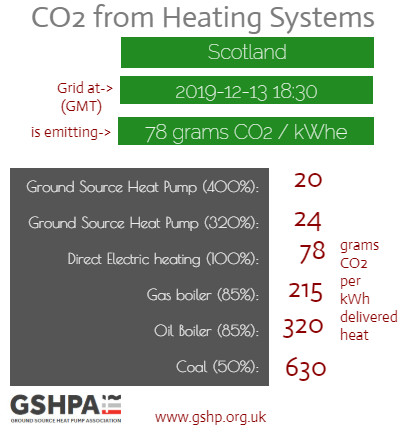SAP 10.1
Published 10 October 2019
SAP 10.1 was published on 10 October 2019 and included a grid carbon factor for electricity of 136 grams CO2e/kWh. This is a dramatic fall from the 233 grams CO2e/kWh that was published in SAP 10.0 in July 2018.
This in turn was a dramatic fall from the 519 grams CO2e/kWh that was published in 2013 in SAP 2012.
These falls in the carbon factor of grid electricity reflect the transition from coal fired power stations toward carbon free electricity generation from wind, nuclear and solar.
A ground source heat pump does not emit any CO2 as it transfers heat from the ground into a building. It uses electricity to effect the transfer and this electricity may come from a carbon free source. If the GSHP uses grid electricity then using a GSHP will cause CO2 to be emitted remotely by the National Grid.
| grams CO2e / kWh |
SAP 2012 October 2013 |
SAP 10.0 July 2018 |
SAP 10.1 October 2019 |
| Mains Gas | 216 | 210 | 210 |
| Electricity | 519 | 233 | 136 |
The following table shows the grams of CO2e emitted per kWh of heat delivered assuming grid electricity is used by a ground source heat pump with a coefficient of performance of 4.
| grams CO2e / kWh of heat |
SAP 2012 October 2013 |
SAP 10.0 July 2018 |
SAP 10.1 October 2019 |
| Mains Gas | 216 | 210 | 210 |
| Electricity | 130 | 58 | 34 |
The CO2e emitted per kWh of heat delivered by a heat pump is now only a fraction of the CO2e emitted by a carbon burning boiler, and even this will fall as the grid decarbonises further.
The implications of adopting SAP 10.1
There are two important implications of the reduction in the grid carbon factor for electricity by 74% compared to the SAP 2012 figure for planning permission purposes:
- The first is that the carbon emissions from electric heating will now reflect the current reality, instead of being many years out of date.
- The second is that technologies generating electricity, such as gas-engine CHP and PV, will only be credited with reducing carbon by the amount of current grid carbon electricity, instead of the historic figure used in SAP 2012.
These long awaited steps are a major improvement in encouraging the transition toward low carbon heating.
See Renewable Heating See Renewable Cooling


